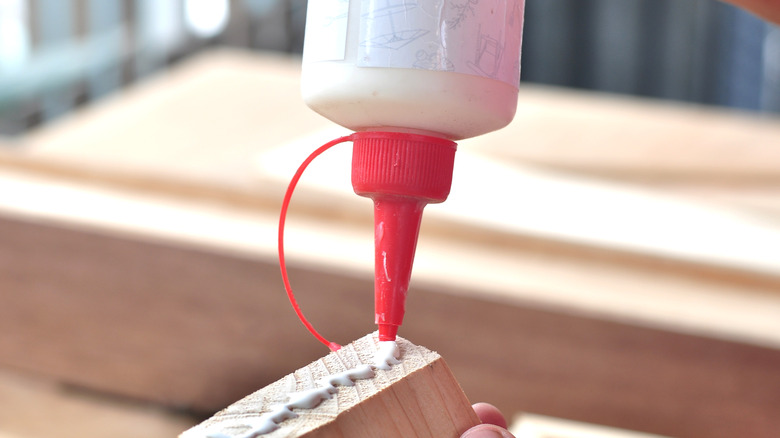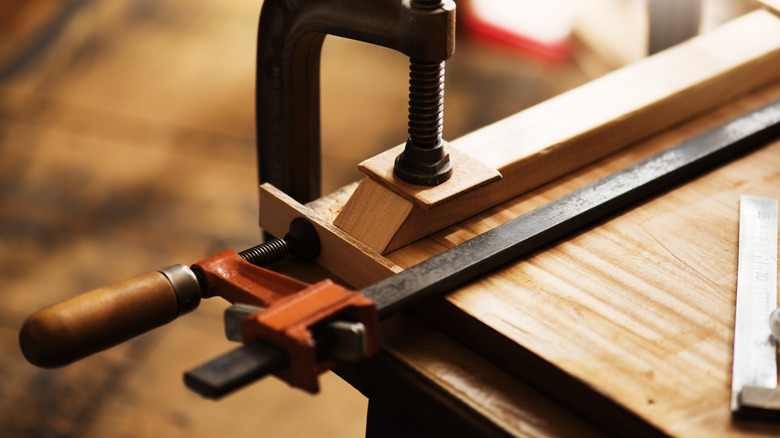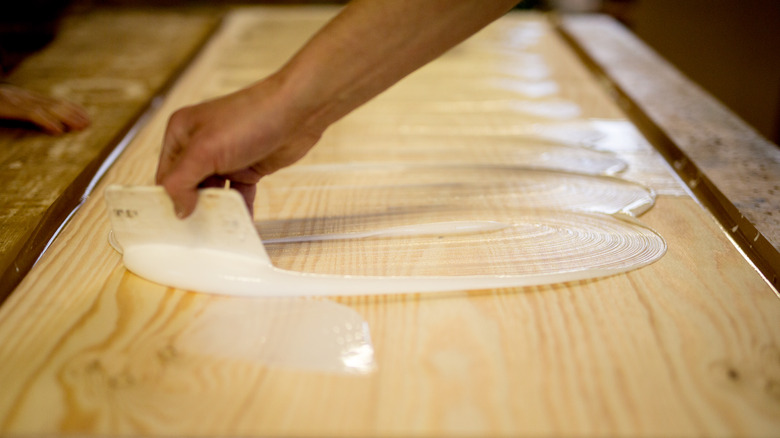The Difference Between Wood Glue Drying And Curing Times Explained
Wood glue is, famously, often stronger than the wood being glued. That is, once you have properly glued two pieces together, they are more likely to break along a grain line in the wood, rather than on the glued joint itself. But there's a gotcha in there. In this case, "properly" means that you've glued your workpiece according to the package directions. If you neglect to let your glued project cure properly, the glued joint could fail and you could find yourself in a worse situation than before you applied the glue. The key is to get a handle on two numbers most glue packaging will give you: the amount of time a glued piece should remain clamped before removing the clamps and handling it (also referred to as "dry time"), and the amount of time the piece should be allowed to fully cure before being used normally (the "curing time").
Anywhere but a woodshop, it might be best to leave the piece clamped and allow the glue to fully cure before handling it at all. But woodworking sometimes requires that you move on a bit faster than that. You might have other uses for those clamps, for example. Or you might be under some pressure to remove excess glue that has squeezed out from your joint, which is best done a half hour or so after clamping, but is a lot easier when clamps aren't in the way.
Clamping time sometimes involves some flexibility
Clamping time is simply the period you should allow your work to be mechanically held together until the clamps can be removed and the piece moved around gently. For most white or yellow polyvinyl acetate (PVA) wood glue, clamping time runs around 30 minutes, but note the package directions, which might require as much as an hour. Titebond, maker of the most well-known PVA wood glues, specifies 30 to 60 minutes. This figure can be longer if you've diluted your wood glue because it was getting too thick. This can seriously hamper your workflow if you need the workpiece out of your way, but it's important to keep the piece clamped so the glued parts don't slip out of alignment when moved around. The good news is that clamping doesn't always involve clamps; in many cases, you shoot a few brads into the glued joint to hold it together while the glue dries. This will usually suffice for clamping, and you can move the piece aside, start glue cleanup, etc. immediately.
In other cases, such as when edge-gluing boards, you'll need to leave actual woodworking clamps in place. Fortunately, even an hour isn't usually the most burdensome wait. Do get the squeeze-out cleaned up as quickly as possible, though. Clean it immediately with a damp rag, or after 20 minutes or so you can cover the drying glue with sawdust, work it into the glue gently, then scrape it away with a chisel or putty knife.
Honor the curing time, or pay the price
If you've supplemented your clamping with brads, you might think the work more solid than it is. But short brads, with their thin shanks and diminutive heads, have less holding power than you'd guess, so it's best to avoid putting the workpiece to use fully until the curing period has passed. For Titebond and most PVA glues, that's 24 hours. There is a situation in which clamping time extends to as much as 24 hours: when the newly glued joint is already stressed, probably as part of the workpiece's design. The good news is that since 24 hours is the usual curing period, you can bypass all of the curing time if the piece has been clamped for 24 hours.
While most woodworkers mean PVA glue when they say "wood glue," there are other types of glue used in woodworking, and each has its own clamping and curing times. Epoxy set times (equivalent to clamping times) can be as short as a few minutes or as long as a week, and a full cure can take much longer. Cyanoacrylate glues (CA glue, or Super Glue) can set in five seconds up to a few minutes, and curing takes 8 to 24 hours. (The short set time is one reason you need tips for extending the life of Super Glue.) Polyurethane glues require clamping for 30 to 120 minutes, and will typically cure within 24 hours.


